Virus classification is the process of naming viruses and placing them into a taxonomic system similar to the classification systems used for cellular organisms.
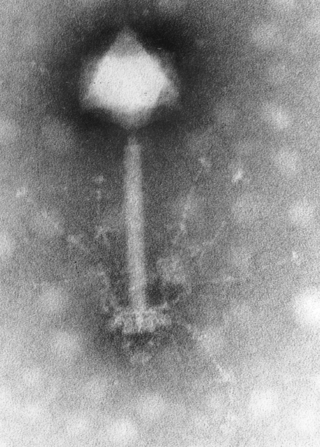
Myoviridae was a family of bacteriophages in the order Caudovirales. The family Myoviridae and order Caudovirales have now been abolished, with the term myovirus now used to refer to the morphology of viruses in this former family. Bacteria and archaea serve as natural hosts. There were 625 species in this family, assigned to eight subfamilies and 217 genera.

Podoviridae was a family of bacteriophage in the order Caudovirales often associated with T-7 like phages. The family and order Caudoviraleshave now been abolished, with the term podovirus now used to refer to the morphology of viruses in this former family. There were 130 species in this family, assigned to 3 subfamilies and 52 genera. This family was characterized by having very short, noncontractile tails. Many former phages in the former family Podoviriade are now classified in the Autographiviridae
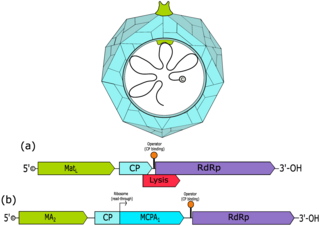
Fiersviridae is a family of positive-strand RNA viruses which infect prokaryotes. Bacteria serve as the natural host. They are small viruses with linear, positive-sense, single-stranded RNA genomes that encode four proteins. All phages of this family require bacterial pili to attach to and infect cells. The family has 185 genera, most discovered by metagenomics. In 2020, the family was renamed from Leviviridae to its current name.
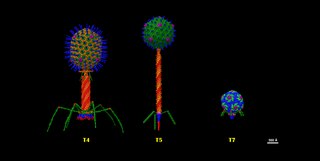
Caudoviricetes is a class of viruses known as the tailed bacteriophages. Under the Baltimore classification scheme, the Caudoviricetes are group I viruses as they have double stranded DNA (dsDNA) genomes, which can be anywhere from 18,000 base pairs to 500,000 base pairs in length. The virus particles have a distinct shape; each virion has an icosahedral head that contains the viral genome, and is attached to a flexible tail by a connector protein. The order encompasses a wide range of viruses, many containing genes of similar nucleotide sequence and function. However, some tailed bacteriophage genomes can vary quite significantly in nucleotide sequence, even among the same genus. Due to their characteristic structure and possession of potentially homologous genes, it is believed these bacteriophages possess a common origin.

Autographiviridae is a family of viruses in the order Caudovirales. Bacteria serve as natural hosts. There are 373 species in this family, assigned to 9 subfamilies and 133 genera.
Escherichia virus 186 is a virus of the family Myoviridae, genus Eganvirus.
Salmonella virus PsP3 is a virus of the family Myoviridae, genus Eganvirus.
Escherichia virus Wphi is a virus of the family Myoviridae, genus Peduovirus.
Mannheimia virus PHL101 is a virus of the family Myoviridae, genus Baylorvirus.
Pseudomonas virus phiCTX is a virus of the family Myoviridae, genus Citexvirus.
Ralstonia virus RSA1 is a virus of the family Myoviridae, genus Aresaunavirus.
Salmonella virus Fels2 is a virus of the family Myoviridae, genus Felsduovirus.
Salmonella virus SopEphi is a virus of the family Myoviridae, genus Felsduovirus.
Yersinia virus L413C is a virus of the family Myoviridae, genus Peduovirus.
Peduoviridae is a family of viruses in the class Caudoviricetes. It was previously treated as a subfamily of the morphology based family Myoviridae, which has been found to be paraphyletic and is no longer recognised. Bacteria serve as natural hosts. There are 126 species in this subfamily, assigned to 58 genera.
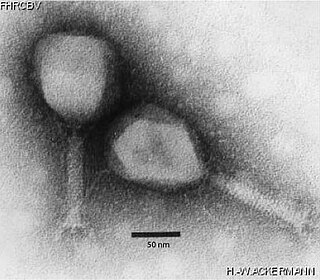
Tevenvirinae is a subfamily of viruses in the family Straboviridae of class Caudoviricetes. The subfamily was previously placed in the morphology-based family Myoviridae, which was found to be paraphyletic in genome studies and abolished in the 2021 International Committee on Taxonomy of Viruses (ICTV) classification. Bacteria and archaea serve as natural hosts. There are 148 species in this subfamily, included in 14 genera.
Eucampyvirinae is a subfamily of viruses in the class Caudoviricetes. Bacteria of the genus Campylobacter serve as natural hosts. There are 9 species in this subfamily, assigned to 2 genera. Prior to 2022, eucampyvirinae was in the class Caudovirales, in the family Myoviridae.
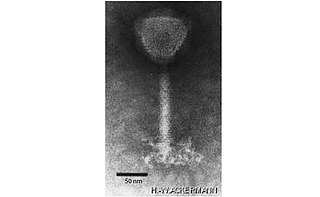
Herelleviridae is a family of bacterial viruses of the order Caudovirales infecting members of the phylum Firmicutes. The family has five subfamilies, 33 genera and 92 species. In average, replication of family members is supported by 70% isolates of primary host species.
Kyanoviridae is a family of bacteriophages in the class Caudoviricetes. The viruses in this family were formerly place in the morphology-based family Myoviridae, which was found to be paraphyletic in genome studies and abolished in the 2021 International Committee on Taxonomy of Viruses (ICTV) classification, although the term myovirus is still used to refer to the morphology of viruses in this new family. Bacteria and archaea serve as natural hosts. There are currently 66 species in this family, assigned to 54 genera.






